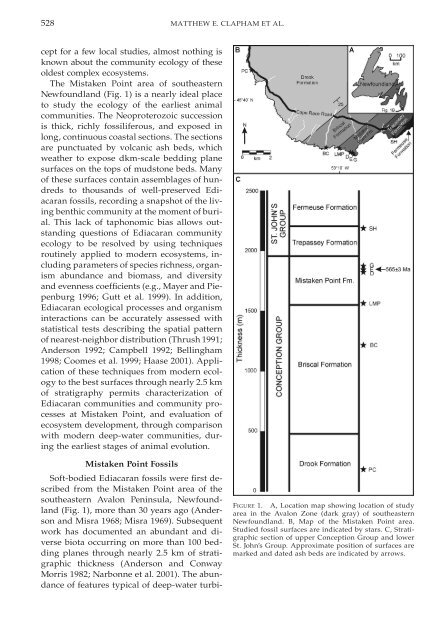Paleoecology of the oldest known animal communities: Ediacaran ...
Paleoecology of the oldest known animal communities: Ediacaran ...
Paleoecology of the oldest known animal communities: Ediacaran ...
Create successful ePaper yourself
Turn your PDF publications into a flip-book with our unique Google optimized e-Paper software.
528 MATTHEW E. CLAPHAM ET AL.<br />
cept for a few local studies, almost nothing is<br />
<strong>known</strong> about <strong>the</strong> community ecology <strong>of</strong> <strong>the</strong>se<br />
<strong>oldest</strong> complex ecosystems.<br />
The Mistaken Point area <strong>of</strong> sou<strong>the</strong>astern<br />
Newfoundland (Fig. 1) is a nearly ideal place<br />
to study <strong>the</strong> ecology <strong>of</strong> <strong>the</strong> earliest <strong>animal</strong><br />
<strong>communities</strong>. The Neoproterozoic succession<br />
is thick, richly fossiliferous, and exposed in<br />
long, continuous coastal sections. The sections<br />
are punctuated by volcanic ash beds, which<br />
wea<strong>the</strong>r to expose dkm-scale bedding plane<br />
surfaces on <strong>the</strong> tops <strong>of</strong> mudstone beds. Many<br />
<strong>of</strong> <strong>the</strong>se surfaces contain assemblages <strong>of</strong> hundreds<br />
to thousands <strong>of</strong> well-preserved <strong>Ediacaran</strong><br />
fossils, recording a snapshot <strong>of</strong> <strong>the</strong> living<br />
benthic community at <strong>the</strong> moment <strong>of</strong> burial.<br />
This lack <strong>of</strong> taphonomic bias allows outstanding<br />
questions <strong>of</strong> <strong>Ediacaran</strong> community<br />
ecology to be resolved by using techniques<br />
routinely applied to modern ecosystems, including<br />
parameters <strong>of</strong> species richness, organism<br />
abundance and biomass, and diversity<br />
and evenness coefficients (e.g., Mayer and Piepenburg<br />
1996; Gutt et al. 1999). In addition,<br />
<strong>Ediacaran</strong> ecological processes and organism<br />
interactions can be accurately assessed with<br />
statistical tests describing <strong>the</strong> spatial pattern<br />
<strong>of</strong> nearest-neighbor distribution (Thrush 1991;<br />
Anderson 1992; Campbell 1992; Bellingham<br />
1998; Coomes et al. 1999; Haase 2001). Application<br />
<strong>of</strong> <strong>the</strong>se techniques from modern ecology<br />
to <strong>the</strong> best surfaces through nearly 2.5 km<br />
<strong>of</strong> stratigraphy permits characterization <strong>of</strong><br />
<strong>Ediacaran</strong> <strong>communities</strong> and community processes<br />
at Mistaken Point, and evaluation <strong>of</strong><br />
ecosystem development, through comparison<br />
with modern deep-water <strong>communities</strong>, during<br />
<strong>the</strong> earliest stages <strong>of</strong> <strong>animal</strong> evolution.<br />
Mistaken Point Fossils<br />
S<strong>of</strong>t-bodied <strong>Ediacaran</strong> fossils were first described<br />
from <strong>the</strong> Mistaken Point area <strong>of</strong> <strong>the</strong><br />
sou<strong>the</strong>astern Avalon Peninsula, Newfoundland<br />
(Fig. 1), more than 30 years ago (Anderson<br />
and Misra 1968; Misra 1969). Subsequent<br />
work has documented an abundant and diverse<br />
biota occurring on more than 100 bedding<br />
planes through nearly 2.5 km <strong>of</strong> stratigraphic<br />
thickness (Anderson and Conway<br />
Morris 1982; Narbonne et al. 2001). The abundance<br />
<strong>of</strong> features typical <strong>of</strong> deep-water turbi-<br />
FIGURE 1. A, Location map showing location <strong>of</strong> study<br />
area in <strong>the</strong> Avalon Zone (dark gray) <strong>of</strong> sou<strong>the</strong>astern<br />
Newfoundland. B, Map <strong>of</strong> <strong>the</strong> Mistaken Point area.<br />
Studied fossil surfaces are indicated by stars. C, Stratigraphic<br />
section <strong>of</strong> upper Conception Group and lower<br />
St. John’s Group. Approximate position <strong>of</strong> surfaces are<br />
marked and dated ash beds are indicated by arrows.

















